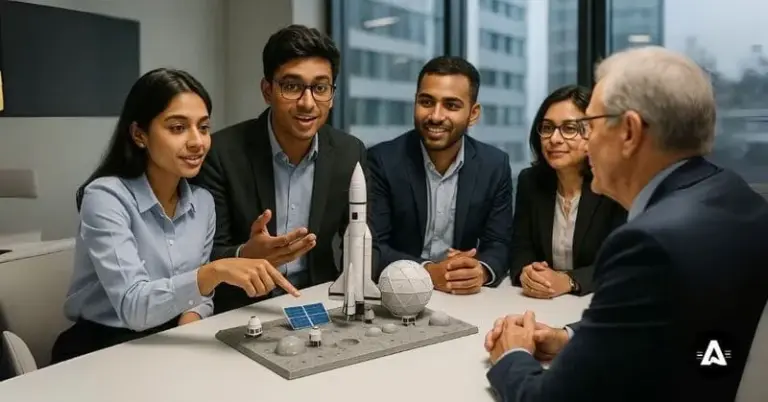How to Pitch a Space Startup to Investors

Learn why it is key to build a strong pitch for space startup if you want to get venture capital for your space startup.
Find out the most important strategies to bring in potential investors at every funding round. This includes the seed stage, Series B, and Series C.
Know how to show your startup’s unique value and bring out the skill of your team members in your pitch.
Look at new and growing spaces in the space economy. These include satellite manufacturing and earth observation.
See how you can show your financial goals, talk about market trends, and plan for exits in ways that speak to investors in the space industry.
Introduction
Getting your space startup noticed by venture capitalists calls for both technical skills and good business ideas. The space industry is growing at a fast rate. Experts believe the space economy could reach $1.8 trillion by 2035. A lot of venture capital is going into the space industry right now. Startups are busy working with new ideas in satellite technology, geospatial AI, and propulsion systems. This article gives you a simple plan to help you pitch your space startup to investors. It will help you make sure your goals match with what they want so you can get the money you need.
Space Startup Investment Guide
A good pitch is about more than just your idea. You need to show how your startup can grow and also talk about what can go wrong. Try to shape your plan so it fits what potential investors are looking for. All parts of your pitch should help them feel sure to make the right investment decision.
When you know what is important to people in venture capital and you shape your pitch for them, you can get more funding. Look at the important steps below. They help you focus on your team’s skills, chances in the market, and how your answers can grow. If you work on these things, your startup can stand out from others in the world of venture capital.
1. Research Your Target Investors & VCs
The first thing you need to do is get to know your investors. You need to find out more about venture capitalists and different groups that have given money to space startups. These could be companies that make satellites, build new engines, or work with earth observation. This will help you know who you will be talking to and what they look for. It is a good way to get ready before you make your pitch.
Check the types of funding rounds that these people and companies support. See if they like to invest in the seed stage, or if they prefer to join in at series B or series C. It is good to find out how much risk they want to take. One example is Space Capital. They are interested in defense technology because of things happening in the world now. When you know what they want, you can make your pitch fit what they look for.
If you match your pitch to the right goals, you have a better shot at getting the money you need. This shows investors that you know about them and have done your work. They want to feel that you see them as real partners and that you share their plan to move forward together.
2. Define Your Unique Value Proposition
Your value proposition is what makes your startup stand out from others. It shows people what is different about you. Your edge may come from using electric propulsion, building new propulsion systems, or using AI in earth observation. Always tell people what is special about what you do. This is how you show why your startup matters.

Show people how your business helps to solve clear problems. You can fix gaps in low Earth orbit satellite coverage. Tell your commercial customers that you also help them break into new markets. For example, Muon Space made an AI-powered satellite constellation. This constellation helps with wildfire risks. It gives answers faster than other choices.
Make sure to show the real benefits for investors. Tell them where they can get significant returns. Show the new markets that your startup, your group, and your technology can help them join. Focus on why nobody else is doing what you do, and why your solution is important in the changing space business.
3. Craft a Compelling Elevator Pitch
A good elevator pitch is short and clear. It shows what your startup does and the mission it has. You should say all this in less than two minutes. Make it short, but make it strong, too. Focus on the most important things your work does in space applications.
Do not use words that are hard to understand. A lot of investors, especially if this is their first time hearing about space startups, want to know what makes your idea special. Talk about how you fix one big problem. Maybe you have better propulsion systems or a new way to do earth observation. Show how your solution is better than the others.
Practice many times so you can say your pitch with no trouble. This lets you feel and look more confident to people, no matter who they are. Your elevator pitch needs to tell people what your company is about. At the same time, you need to get them interested and help them trust you.
4. Highlight the Problem and Market Opportunity
Show investors how real your startup’s problem is. You can say there is waste in satellite manufacturing. Or, there is not enough coverage in low earth orbit. These are big issues. They need someone who can bring new ideas and good answers.
The space industry is growing fast. The World Economic Forum says the value of the space industry will go up by 9.14% every year. By 2035, the space industry could be worth $1.8 trillion. A big part of this growth comes from what commercial customers want and need. More companies use space technology for their work. These commercial customers help push the space industry to grow. They bring new ideas and uses for space that help make the industry even bigger. All of this means there is a big chance for growth in the space industry, driven by these commercial customers.
Make a link from your fix to bigger space systems or to new tech. This way, people will see why your work matters today and how much it can grow over time. When you give facts and hard numbers, investors see the possible significant returns if they go ahead and put their money in with you.
5. Present Your Solution and Technology Clearly
Investors need to know about your technical innovation. But they do not want to read words that are hard to understand. Use simple terms to explain the science behind what you offer. For example, say how you use electric propulsion or talk about how you built your spacecraft. This way, they can get your idea faster and feel good about what your work adds.
Try to make your point by using examples that people in general can relate to. For instance, you can explain how your AI-powered satellite constellations like FireSat work by sharing images that show real-time wildfire detection. This is a good way for the general public and experts to get what you are saying. It helps make your message clear to everyone.
Be clear about what your solution can do and why it is better than what others have. This way, people can trust your work. It will also help your idea stand out from others. When you speak to people about electric propulsion or AI in the spacecraft world, keep your words simple and direct. This helps people get interested and understand your work.
6. Showcase Traction and Achievements
Showing your progress is important when you want to build trust with potential investors. Tell them about your big wins. For example, talk about sending your first satellite into space. You can also share that you work with big aerospace companies like Lockheed Martin.
Share numbers that show your startup is moving ahead. You can talk about early sales, test projects, or big partnerships you may have made. For example, Muon Space signed contracts worth $60 million to send satellites into space by 2026. This shows that the startup is growing strong in the market.
When you share exact results, it shows potential investors that your startup is ready to get more funds. Let them see how far you have come. Show them why the wins you have now will help your startup grow even more later. This makes it clear that you are ready to take the next step.
7. Explain Your Business Model
Our startup makes money by building and selling satellites to businesses and other groups. A big part of our income comes from our work in satellite manufacturing. We also make money by letting other companies use our special technology under a license. This helps more people get access to our tools, and we get paid for it.
We do not sell user data to make money. Most of our commercial customers are in industries like telecommunications, defense, and weather. They use our satellites and technology to improve the way they do business. These strong ways of bringing in revenue help us to keep growing and reach new markets.
Tell people about your pricing plans and explain how they fit what users are looking for today. Does your business offer options that let you grow? For example, you could offer a subscription plan that gives people regular access to geospatial data analysis. You might also do custom work for aerospace companies.
Make sure the options you give can meet the needs people have now, and that you can change or add more as they need it. This way, your products and plans can work well for both small groups and larger businesses that want to use geospatial analysis or aerospace services more. Let users know that these choices are made for all kinds of needs, so people feel sure they will get what they want from you.
Let investors know that your company is part of the bigger world of space satellites and services. Show them that your business is steady and knows how to keep up with changes. In the fast-moving areas of satellite manufacturing and aerospace, it is important to be ready to change and grow. Being part of the space satellites industry means your company is working hard to stay on top. Investors can feel good knowing you are ready for new things in the future.
8. Detail Your Go-to-Market Strategy
Say how you plan to reach customers and go into new markets. Be clear about what way you will take. You can talk about whether you want to use direct sales, work with partners, or build special collaborations. Let people know what your main focus is, so they understand how you will grow.
For example, start-ups like Pixxel use their hyperspectral imaging platforms. They work with commercial groups that want good and detailed data about the environment. Investors look for ways that help a business stand out from others.
Show the numbers and set clear deadlines to prove that your plan will work. A well-planned go-to-market strategy helps people feel sure about what you are doing. It makes all the steps you will take easy to see and links them to what makes your business good for people.
9. Emphasize the Team’s Expertise and Experience
Investors want to see the people who are building your startup, not just what the technology can do. Make sure you show the team’s skills. Talk about any members who worked with NASA or in big aerospace companies like Muon Space. This helps people get to know your team and shows why they can trust your startup. It is a good way to make people feel good about your startup and what your team can do.
Talk about how the founding team has good experience in tech startups or big projects in the space industry. Show that there are people in the team who come from different backgrounds and have different skills. This can help the company do well in the long run and stand out from others. A strong and skilled founding team makes a big difference, especially in the challenging world of tech and the space industry.
Let people see why your team can be better than others in this fast and hard field. Talk about how your team’s time in the space industry or at NASA links to what your startup wants to do. By doing this, you help investors feel sure about your startup. They can know why it could grow into a top name in aerospace and tech.
10. Address Challenges and Risk Mitigation
Every new idea can run into some problems. You need to think about what might go wrong. There can be rules that you have to follow. There might be times when there is not enough money. Show the steps you will take to deal with these risks.
It is very important for us to follow the rules in places like the United States and India. This helps show that your money is safe. We make sure we stay in line with the laws and all needed steps in these countries.
I also want to share what we plan to do between our funding rounds. For example, there is a time between Series B and Series D where we will work to hit our goals. We will use your support to grow, fix any problems, and get ready for the next step. This plan helps keep the business strong and gives you more trust in what we do.
If you speak about these issues early, potential investors will see you are ready. They will know that you can handle hard times and still keep going forward.
11. Demonstrate Scalability Potential
Speeding up growth is important if you want to get investment. You need to show that your business model can get bigger. You can do this by going into new markets. You can also try using new technologies like AI in satellite groups. This will help people see that your business has a good future.
Use case studies to talk about times when you reach big goals for your business model. You can also use them to talk about new things you plan to share, like geospatial analytics. When you work with well-known companies, it shows that your business model can grow and do well with others.
Let people who want to invest know that if they choose your company, they will have a chance to join the growing space economy. This can help them get significant returns as the years go by.
12. Illustrate Financial Projections and Funding Needs
Share clear plans that help investors see how the company can grow. Show numbers like how much money you expect to earn and where the money will be spent over the next five years.
Talk about the funding needed for the next round, like Series C. Explain how this money can help to make the technology better or help the company grow in the market. This new capital will let the business work on new products, make their current services even better, and reach more people. Getting Series C funds also gives the team a chance to try out new things, go into more places, and be stronger in their field. With this backing, the company can move faster, hire more good people, and stand out from other companies.
Year | Revenue ($M) | Expenses ($M) | Funding Round | Key Milestone |
|---|---|---|---|---|
2024 | 2 | 3 | Seed | First satellite launch |
2025 | 8 | 6 | Series B | Entry into new markets |
2026 | 25 | 15 | Series C | Commercial contract wins |
13. Provide a Roadmap and Milestones
Set small goals for the short term and long term. You can plan when to launch a satellite or when to start getting new customers in areas where no one else has been. Connect these goals with your different funding rounds, like Series B. This way, you know what to do and when to do it.
Let investors see that meeting these goals can help you get better returns. Show how this fits with what you want for your company. You can use an example. For instance, you can talk about a plan that connects your Series B with entering two new markets. This will show you are moving forward and making good progress.
Finish by telling them about your exit strategy. This could mean going public through an IPO. It could also mean selling the company by merging with others. You might want to talk about plans to work with big aerospace companies, such as SpaceX. This helps show investors that there can be big gains.
14. Prepare for Technical Due Diligence
Technical checks are always done. You need to have key documents ready that show how your technology works. This may be patents or proof that you follow the rules.
Get ready, because venture capitalists, like the people at Y Combinator, will ask a lot of questions. They want to know if your design can grow as you get more customers. They will also want to be sure that your ideas are really your own.
Good documents help people trust you. They also make it easy for people to put money into your idea. This is because you answer any hard tech questions early on.
15. Share Partnerships and Collaborations
Working with big names like Lockheed Martin or Muon Space can help your startup in a big way. When you work with these groups, it shows people you have their trust. If people or teams pick your startup for group work or to help on projects, others see that you do good work.
Also, being with big names means you are more likely to get good chances to grow. Big companies often know a lot, and they can guide you or help you get new jobs. This can be great for you as well as your startup.
If you get support from Lockheed Martin or Muon Space, people will see your startup as strong and honest. It is a good sign for your name, and can help you get even more people to work with or buy from you.
These partnerships can help you reach more of the market. They let you share new ideas faster. When you work with well-known teams, people trust your work more. For example, if your startup works with others on earth observation satellites, it shows you have a good business plan.
Having these connections helps people feel good about your startup. Investors see that you have support from others. They feel you are ready to do well, even when things get hard in this line of work.
16. End with a Clear Ask and Next Steps
Finish by saying how much money you want to bring in and what you will do with it. For example, you can plan to raise $15 million in a Series C. You may use this money for new work on spacecraft.
For the next steps, interested venture capitalists can set up follow-up meetings to talk more about our plans. We can also give you access to our data room. This will help you look at all the information you need before you make a choice. If you want to move ahead, please reach out, and we will share what to do next. We are here to make sure you get everything you need about this deal.
Do not leave any questions without answers. Give clear steps, so potential investors know what to do next. This will help them feel ready to decide. It can also make them want to get more involved.

Tips for Delivering a Memorable Space Startup Pitch
Getting better at your pitch is very important. When you talk to investors, try to use a good story. Do not talk only about the technology you have. Mix in stories about how the market has changed over time, too. For instance, you can tell people how Starlink helped to start satellite IoT. This way, people in the room will be much more interested in what you say.
Use good visuals such as diagrams, charts, or models. These can make hard ideas easy to understand. You need to change your presentations for Indian investors and international investors. Make sure the stories and jokes you use fit the place and time. This will help people feel a connection to your words.
The next part will share tips that help you show your ideas in a better way. This can help you have more impact.
Practice Storytelling with Data and Vision
Stories make people feel close and part of something. You should show data to let people see how your startup’s market can get bigger. Then, connect this to how you plan to make something new later on.
Mix facts with easy-to-understand stories that show why your startup is important. For example, you can talk about how your startup helps save forests all around the world by using geospatial analytics.
When you talk to people using facts and big dreams, your pitch will make them trust you. It will also get them excited about what you want to do. This way, you have a good chance to get their support.
Use Visuals for Complex Concepts
Complex things in technology can be hard for people to understand. That is why it is good to use pictures like infographics or diagrams. These can help show how things work, like spacecraft propulsion systems. Using these visuals makes it easier for people to get the main ideas about propulsion systems and how they help spacecraft move.
Data visualisation is a good way to show people, including those who are not experts, what is happening. It helps investors and others see the main ideas in a clear way. Data visualisation can make hard systems or ideas easier for them to understand.
Do not put too much information on your slides. A clean presentation helps people focus. It allows the visuals to highlight your important message. This way, nothing gets in the way or makes the main idea hard to see.
Tailor Your Pitch for Indian and Global Investors
Every investor is not the same. Each one has their own needs and what they look for. You should change your pitch to fit what matters most in each place. For example, in India, you need to talk about the rules that are important there. But for aerospace news in other countries, you should focus on different things.
Talk about things that people in every part of the world care about. At the same time, be sure to mention points about special culture or new technology from each area.
Investors feel good when you make your talk or presentation feel like it is only for them. If you show that you get their world and what they think is important, they will be more into what you say. This makes them want to work with you.
Manage Time and Keep It Concise
Good pitches happen when you pick the right time and say things clearly. Keep your talk short and to the point, so potential investors will get the main ideas of your startup fast. Do not give too many details at once. Give each topic its own time to stay clear. Talk about your business model, team members, and commercial customers. Do it fast and simple to keep people interested.
You should use clear pictures or slides when you talk about propulsion systems or earth observation. These tools can help people see what you mean. Do not use too many big words. Keep your talk about the startup easy to follow. This way, everyone can get what you say.
When you do this, you show people that you care about their time. This makes your pitch look better and more interesting to them.
Anticipate and Answer Investor Questions
Knowing the questions that potential investors might ask can help make your pitch much better. Clear answers will show you are ready and sure about your business model, how much money you need, and what your exit strategy is. If there are worries about market competition or rules, bring these up early. Be ready to explain things like propulsion systems or satellites, so you look honest and reliable. Talk about your founding team and what experience they have, as well as your work with other well-known space companies. A pitch that touches on all these points will get more attention from venture capitalists and help build trust with them.
Common Mistakes to Avoid in Space Startup Pitches
When you add too much tech talk in your pitch, you might make potential investors lose interest. These people want to see how your startup can work in the space economy. They look for ideas that can grow and make a difference. Do not forget about the groups that are your market competition. You need to know who is working in this space, like new tech startups and big businesses such as Lockheed Martin. This helps your startup be noticed by others.

It is not good to ignore rules or policy problems, especially if you are in India. Investors want to know that you see these things and will do what is needed. This makes them feel sure about your business. It helps them think that you can move forward and get significant returns.
Overloading with Technical Jargon
When you talk about your startup, it is good to share important ideas without making things too hard to follow. You need to share these ideas in the right way. If you talk too much about “electric propulsion” or “propulsion systems,” you might make it hard for potential investors to follow along, especially if they are not from the aerospace world. You have to turn these hard ideas into something simple that people can get. At the same time, show how the new tech would work in everyday life. Try not to use too many tough words. Keep it easy so everyone can see why your idea is good. When you share your thinking in a way that people feel close to, they can see the real worth in what you do. This makes them want to understand, feel ready to talk about it, and feel good about making an investment decision.
Underestimating Market Competition
It is very important for a startup to know about the competitive landscape when trying to get funding in the space economy. A lot of investors want to see how your business compares to space companies like SpaceX and Lockheed Martin. In your presentation, you should make it clear that you know who your competitors are, what the different market situations look like, and where you fit in with other companies. This helps you show you are ready for the space economy and makes investors feel more sure about your startup.
Talk about what makes you stand out and why commercial customers should choose you. Show that your business model is ready to handle any problems that other space companies might cause. When you understand your competition and point out their issues, you help investors see that your startup could give them good returns.
Ignoring Regulatory or Policy Challenges in India
Getting through rules and policies in India is a key part of doing well for any space startup. Investors often look at how much a company knows about the law, and if they keep up with new rules. When a startup works with those in charge and follows all the laws, it helps build trust. This is very important during funding rounds or when going for private investment. If you show that your business model already works well to lower the risks from rules, it lets potential investors know that you are careful and smart. The way you manage these things can shape the investment decision. It can also help your startup last longer in the space economy in India.
Failing to Show Commercial Viability
Showing that your space startup can make money is important if you want to get potential investors. They want to know that your business model will bring in steady money, not just now, but for a long time. This matters in an area where companies like SpaceX and Lockheed Martin already have a strong place. Try to share real numbers about the target markets. Give clear numbers about your commercial customers and show your revenue projections. This will help you build trust with people who may put money in your startup.
Working with the top companies or starting pilot projects can also help your startup. If you can show that you have partnerships or real plans to make money soon, it helps you stand out. This is good when you look for money in funding rounds.
Conclusion
Raising money for a space startup can be hard. But if you know what problems can come up, it can help you a lot. You want your pitch to be clear and simple. This will help potential investors feel good about your startup. Make sure you also know about the other companies who are doing the same thing. You need to understand the rules you have to follow too. When you show this, it tells others that you are ready for this market.
It is important to share how your business model will help you make money. This is even more key if you are in a fast-growing field like satellite manufacturing or earth observation. If your founding team is prepared and your story is strong, people will feel a connection to you. When you also have the right plan for your startup, you will have a better chance to get the financial investment you want.
Frequently Asked Questions
Investors who put money in Indian space startups want to see new and smart technology. They also look for a strong business model. A team needs to show they can do the work well. Investors look for a real need in the market for what the company gives people. They also want to see if the business can grow over time. It is important for a company to be better or different from others in the same space. Taking care of any rules or laws is needed, too, because it helps investors feel good about trusting the company.
To make your startup pitch stand out, tell a strong story that shows what makes your idea different. Use simple words and clear pictures to help people understand what you are saying. Do not use hard space words in your pitch. Think about what the investor is looking for and focus on that. Talk about how your startup fixes real problems in the space world. This way, your pitch will be strong and easy for everyone to get.
Before you go and pitch, make a business plan and do some financial projections. Write an executive summary, too. Add a market analysis to show where you fit in. You should also include short bios for each team member and put in any legal papers or patents your startup needs. When you keep all of these things in order, you can show what your startup can do in a clear and strong way to investors.
A normal pitch for a space startup should be about 10 to 20 minutes long. This gives you enough time to talk about the most important things and keep the people listening interested. You need to practice so you can say all the key points in a clear way. Try not to add too much information. You do not want to lose their attention.




